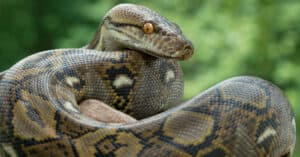Introduction
When it concerns the remarkable globe of serpents, few species record the creativity quite like the baby tiger snake. Understood for their unique coloration and powerful poison, these serpents are an essential component of Australia's one-of-a-kind community. In this detailed article, we will delve into various facets of baby tiger snakes, including their actions, environment, and how to safely communicate with them. Whether you're a wildlife enthusiast or simply curious concerning these creatures, recognizing child tiger snakes can aid promote a deeper appreciation for nature.
Baby Tiger Snakes: What You Need to Find Out About Their Actions and Habitat
What Are Baby Tiger Snakes?
Baby tiger snakes are adolescent kinds of the extremely venomous varieties understood scientifically as Notechis scutatus Browse this site These snakes are primarily discovered in seaside regions of Australia, especially in Tasmania and southern Victoria. As they grow, their pigmentation changes from an extra soft combination to the characteristic yellow and black bands that give them their name.
One noteworthy aspect of infant tiger snakes is their size; hatchlings typically gauge around 25-30 cm in size. Despite their tiny stature, they possess a shocking quantity of poison that can be destructive to humans if bitten.
Physical Characteristics
Tiger snakes have several essential physical characteristics:
- Coloration: The distinct banding pattern commonly comes to be more noticable as they mature. Size: Grownups can get to sizes of up to 2 meters. Body Shape: They have a durable body that assists in swimming and terrestrial movement.
Where Do Child Tiger Snakes Live? Understanding Their Habitat
Understanding the habitat preferences of infant tiger snakes is essential for both preservation efforts and public safety and security. These snakes prosper in different settings:
- Wetlands: Marshes and swamps give enough searching grounds. Coastal Regions: Typically found near coastlines where they can hunt for prey. Woodlands: Thick greenery supplies cover from predators.
Geographical Distribution
Tiger snakes are predominantly discovered along Australia's https://postheaven.net/rewardfrcb/conservation-of-australias-venomous-snakes-the-duty-of-education-and-awareness southerly shoreline, including:
- Tasmania: Home to among the most infamous populations. Victoria: Specifically in areas near water bodies.
Are Tiger Snakes Venomous? A Deep Dive into Their Venom
One common question occurs when reviewing child tiger snakes: "Are tiger snakes poisonous?" The solution is a definite yes!

Venom Composition
The venom of tiger serpents consists of neurotoxins that can trigger paralysis, coagulopathy (blood clotting issues), and possibly fatality if unattended. Right here's what you need to know:
- Effects on Humans: An attack from a tiger serpent can bring about symptoms like swelling, discomfort at the bite site, queasiness, and also respiratory system failure.
Comparison with Various other Venomous Snakes
In contrast to other Australian snakes such as the eastern brownish serpent or king brown serpent, tiger serpent poison is considered among the most potent. Nevertheless, deaths are uncommon because of improved clinical treatments and accessibility to antivenom.
Behavioral Patterns of Infant Tiger Snakes
Understanding just how infant tiger snakes behave is essential for those who Bite Location stay in or check out locations where these reptiles are prevalent.
Nocturnal Habits
Most infant tiger snakes show nocturnal behavior. They tend to forage for food during cooler evening temperatures. This versatility helps them prevent killers while boosting their hunting efficiency.
Hunting Techniques
Their searching strategies consist of:

- Ambush Predation: Waiting still up until victim comes close. Active Foraging: Proactively relocating through greenery or along rivers looking for food.
First Help for Snake Bites: What You Must Know
Despite being fascinating animals, encounters with baby tiger serpents can result in dangerous situations if attacks take place. Knowing first aid treatments can conserve lives.
Immediate Tips After a Bite
Remain calm; panic boosts heart rate. Immobilize the affected limb using a splint or bandage. Seek instant clinical attention-- antivenom may be necessary.Creating a Snake Bite Emergency Treatment Kit
A well-prepared emergency treatment package ought to consist of:
|Item|Purpose|| ------------------------------|--------------------------------------|| Compression bandage|To immobilize the arm or leg|| Splint|Maintains busted bones or joints|| Antihistamines|Reduces allergies|| Emergency situation contact numbers|Quick access during emergency situations|
Common Myths Regarding Tiger Snakes Debunked
Many misconceptions border these fascinating reptiles; let's make clear some mistaken beliefs generally held by people.
Myth # 1: All Tiger Snakes Are Aggressive
While some people might display defensive habits when threatened, not all tiger snakes display aggressiveness in the direction of humans unless provoked.
Myth # 2: Infant Tiger Snakes Are Less Dangerous Than Adults
This myth could not be even more from the reality! Child tiger serpents have nearly as much poison as grownups relative to their dimension; therefore they present significant dangers if bitten.
FAQs About Baby Tiger Snakes
What do child tiger snakes eat?- They largely take in little mammals, birds, frogs, and fish.
- Look for slim bodies with faint banding patterns that become a lot more pronounced as they mature.
- Yes! Birds of prey and larger reptiles may target them.
- Typically every couple of weeks as they proliferate during their early life stages.
- While some individuals do keep them unlawfully without permits as a result of their unsafe nature; it's normally not advised given their venomous status.
- With prompt clinical therapy-- including antivenom-- the survival price is high!
Conclusion
In recap, recognizing infant tiger snakes-- what they eat, where they live, how they act-- can equip us with beneficial expertise concerning these exceptional yet dangerous creatures. The significance of education and learning surrounding first aid actions can not be overstated; knowing just how to react effectively after a bite could conserve lives while promoting regard for our wriggling neighbors within Australia's abundant biodiversity range.
By valuing these snakes' functions within communities-- and identifying potential risks-- we promote conjunction as opposed to fear-based reactions toward one another's existence in nature's grand tapestry! Whether you're an enthusiastic walker considering your next adventure or just curious concerning regional wild animals experiences near home-- this guide functions as your relied on recommendation point on the enigmatic world occupied by our good friends-- the splendid baby tiger snake!